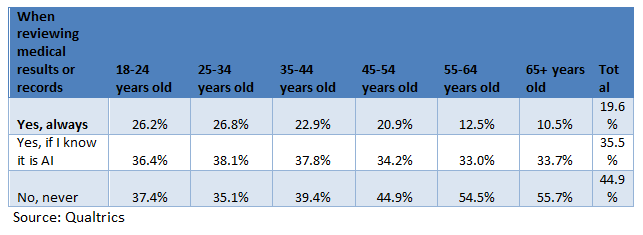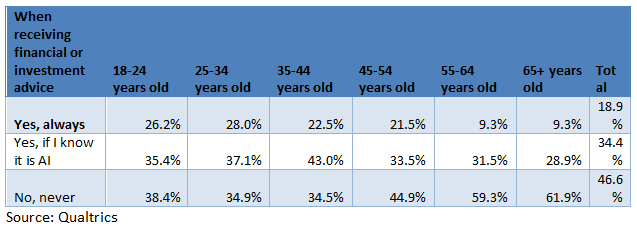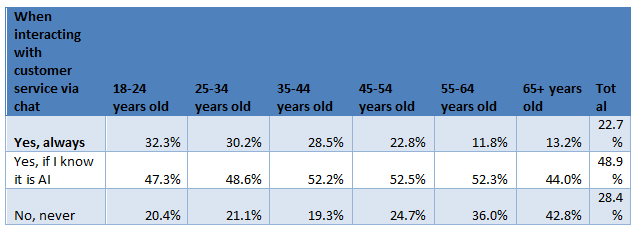Welcome to No Jitter's Number of the Month, where we dig deeper into the research and data that's shaping the communications technology industry. This month, we look at a report from Qualtrics, a cloud-native software provider that provides customer and employee experience management solutions.
Per the company’s press release, Qualtrics’ research found that:
- 72% of consumers surveyed said they are generally comfortable with the idea of talking to chatbots for their customer service needs.
- 55% of consumers are comfortable with AI tech being part of their medical and financial matters.
To dive deeper into these numbers, No Jitter (NJ) received additional data from Qualtrics and corresponded via email with Bruce Temkin, Head of Qualtrics XM Institute. Also, NJ spoke with Ellen Loeshelle, Qualtrics Director of AI Product Development who shared her insights on AI but not on the data presented here. That conversation is available as a companion Q&A.
Focus on this number of the month: 55%
That’s the percentage of consumers who said they are comfortable with AI tech being part of their medical and financial matters. The number comes from a Qualtrics study of 2,013 adults across the U.S., UK, France, and Germany aged 18+. The study was fielded between May 16 and June 1, 2023.
Why Are More Than Half of Consumers Comfortable With AI Being Part of Their Medical Or Financial Matters?
Fifty-five percent grabbed NJ’s attention because it seemed high and therefore worthy of deeper inquiry. What drove this high percentage? As with prior Number of the Month articles, generational preferences around technology drive which populations are embracing AI.
The following table shows how the willingness to have AI be part of “reviewing medical results” breaks out by age range. NJ used a table because it shows the 55% (add both “yes” responses) who are willing to have AI involved.
The table also shows “breakpoints” between those aged 44 and younger versus those aged 45 and older. In the “Yes, if I know it is AI” response, look at the 3.6% drop between 44 and younger versus 45 and older. In the “No, Never” response there is a 5.5% increase, meaning that the older age groups are more unwilling to have AI involved. categories. In the context of other “Number of the Month” articles, this is roughly a split between Millennials (and those younger) and Gen X (and those older).
Also note the sharp drop in “yes, always” between those 45-54 years old versus those 55-64 years old. That is roughly a split between Gen X and Boomers, so even there is difference in the acceptance of AI.
The use of the generation categories (Gen Z, Millennials, Gen X, Boomers) will be discussed in a bit more detail later in this article.
Comfort With AI When Reviewing Medical Information
The following table shows the willingness to have AI involved when receiving financial investment advice. Again, note the sharp changes between age ranges. But here, the breakpoints shift slightly. For example, in the “yes, always” there is a ~6% difference between 25–34 year-olds and 35-44 year-olds. In that same response, there is ~12% drop between those 45-54 years old and 55-64 years old.
Comfort With AI When Receiving Financial Advice
The following table shows the willingness to have AI involved when receiving legal advice. The breakpoints here are less evident – obviously the ~14% drop from 45-54 to 55-64, which is consistent with trends noted previously, is an exception. What is not consistent is in the “Yes, if I know it is AI” response where there’s a 6% increase from 18-24 to 25-34, and then a 5% drop to 35-44 – and then the percentages fluctuate in the remaining age ranges.
Comfort With AI When Receiving Legal Advice
Why does this fluctuation by age group exist? And why did the breakpoints shift younger in the “financial advice” category. It’s hard to say because NJ did not have full access to all the results. It is possible that a different crosstab (or other type of analysis) could reveal a different relationship between variables. Or it’s possible that there’s something inherent to financial advice versus medical advice that involves lower risk tolerance.
Another possibility has to do with methodology and segmentation by age. According to some definitions (Beresford and Kasasa and Mental Floss) the 25-34 and 35-44 age group actually spans the entire Millennial generation. And there’s a bit of “bleed” across the other age groups relative to some definitions of the generations (this article shows how Twilio defined them in their study). If those two categories were combined…and it was somehow possible to filter out the older Gen Z and younger Gen X, then maybe the fluctuation would remain, vanish or grow more pronounced. There’s no way to know.
The following table shows the willingness to have AI involved when receiving legal advice. There are two notable breakpoints in the answers to this question. In the “yes, always,” response there is the ~3% drop from 35-44 to 45-54 which is consistent with the above trends, as is the ~5% increase in the “no, never” response between 35-44 and 45-54 year-olds.
Comfort with AI When Reviewing Legal Contracts
To summarize the trends identified above:
- In all cases, only about 20% of consumers are “always” comfortable interacting with AI regardless of the situation. Consumers aged 44 and younger are more likely to be “always” comfortable than older consumers (45+).
- For the response “Yes, if I know it is AI” a larger percentage of consumers are comfortable interacting with an AI regardless of the situation. And, overall, consumers 44 and younger are more likely to be comfortable than older consumers (45+).
- For the response “No, never,” older consumers are more likely to never be comfortable with AI versus those 44 and younger.
With those points for context, consider the following table which shows how the 72% (add the two “yes” responses together) of consumers who are comfortable interacting with AI for customer service breaks out by age range.
The first observation is that the percentage of responses answers “Yes, always,” and “Yes, if I know it’s AI” is several percentage points higher than in the results shown. This suggests that, yes, overall comfort is higher. But note the “breakpoint” in “yes, always,” remains between those 44 and younger and those 45 and older – same as with the results above.
Comfort With AI When Interacting With Customer Service Via Chat
Qualtrics asked respondents the same comfort question across several other areas: reading news articles, reading day-to-day company/school communications, reading company/school communications about sensitive topics, and when looking at art. Overall, the same trends were observed:
- Generally higher degree of comfort in those areas as compared to the medical, legal, and financial topics.
- Similar breakpoints between those 44 and younger and those 45 and older.
NJ asked Qualtrics why this trend might exist. Via email Temkin said, "Younger people have grown up with more technology and have become more accustomed to analytically driven recommendations which they experience all the time on sites like TikTok and Instagram.”
He continued and provided more context for some of the survey questions. “We also asked generally how people feel about new technology, and younger people (35 and under) were much more likely to say they are early adopters or at the forefront of trying new tech than older people, who were more likely to wait for technology to become mainstream. As early adopters in general, younger people are more comfortable trying new and emerging technologies like AI."
Despite that comfort level with new and emerging technologies, there remains a broad level of concern about privacy and security. For example, the Qualtrics survey asked: "How concerned are you about the privacy and security of your personal information when interacting with an AI-powered customer service chatbot or virtual assistant?" The following table provides those results, split by age.
Again, the data suggests that the older age ranges are more likely to be “extremely concerned” than those aged 44 and younger, while the distribution of responses across “somewhat concerned” is more even. Then it flips, those 44 and younger are more likely to be “slightly concerned” than the older age groups.
Concern About Privacy and Security When Interacting With AI
NJ asked Qualtrics a similar question about interacting with humans – the premise being that a bot's not going to steal a credit card number or my identity unless it's programmed to, but a human might. A human might also make errors that comprise privacy/security.
Temkin said that in this survey they didn’t ask about interacting with humans and a sense of trust/security. But he indicated that it was a potential topic for inclusion in follow-up studies.
He went on to say that security is definitely a priority: “In our separate research specifically asking CX professionals about AI, the majority (60%) of professionals recognized that customers may be concerned about their data privacy. The most common ways they’d alleviate those concerns were letting customers opt out of their data being used and sharing with customers how their data was being used.”
Previous editions of “Number of the Month,” have shown that the generations really do respond differently to various technology trends in personalization, service, etc. And now it appears that thread is common to AI, as well.
Want to Know More?
To learn more about how consumers respond to interactions with AI:















